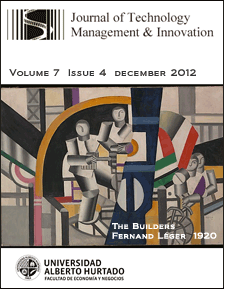Technology Commercialization: Indian University Perspective
DOI:
https://doi.org/10.4067/S0718-27242012000400010Keywords:
Technology commercialization, Intellectual Property Rights, Bayh Dole act, PFIP Bill, Licensing authority, etcAbstract
Technology transfer is the complete, enabling disclosure of advancement in Science and technology, sufficient for its unfettered use and improvement. Universities and institutions of high end research and learning are the focus of such knowledge economy. University- industry partnerships in the field of Science and technology are complex and develop through a large number of mechanisms. The protection and the licensing mechanism of Intellectual property rights at such institutions are the focus of attention of the policy makers at all levels, including the Parliament, wherein a bill has been passed recently, PFIP Bill,2010, which emulates the technology commercialization at US University through Bayh Dole Act. A detailed commercialization process has been evaluated and the success of such technology transfer analysis and commercialization has been reviewed with reference to controlling parameters and revenue being generatedDownloads
References
Albert N Link and John T Scott, US Science Parks: the diffusion of an innovation and its effect on the academic mission of Universities, International Journal of Industrial Organization, 21(2003), 1323-1356
BAyh Dole Act, (PL 96-517), Patent and Trademark amendment act of 1980, USA.
Everett M Rogers, Jing Yin and Joern Hoffman, Assessing the Effectiveness of Technology Transfer Offices at US Universities, AUTM, Journal, XII, 2006
Inzelt A.: The evolution of university–industry–government relationships during transition, Research Policy, (2004), Vol. 33, pp. 975-995
Jospin. L.,Towards the factory of next century, In: Innovation and Technology Transfer. European Commission, Luxembourg, January 1998, pp. 16–21
Kumar, V., Jain, P., Commercialization of new technologies in India: an empirical study of perceptions of technology institutions,Technovation, (2001), 4.1.0, pp.1-8
Prabhu Ram,Tech transfer in the Indian Public research System, Research Global, pp 10-12, Oct 2008 www.prsindia.org/uploads/media/1229425658/LB_protection
Rosenberg, N., Nelson, R., 1994. American universities and technical advance in industry. Res. Policy, 23, 323–348.
Report of the Steering Committee on Science and Technology, for 11th Five Year Plan( 2007-2012), Planning Commission, Govt of India, Dec, 2006
Shalini Gupta, SBRI funded companies taking Wings, Biospectrum India, June, 2008, www.biospectrumindia.ciol.com/content/coverstory.
Shane, S., University technology transfer to entrepreneurial companies, Journal of Business Venturing, (2002), 17, pp. 1-16
Status Report on Technology Business Incubation in India 2009, NSTEDB, DST, New Delhi www.dbtindia.nic.in
Downloads
Additional Files
Published
How to Cite
Issue
Section
License
Copyright (c) 2012 Journal of Technology Management & Innovation

This work is licensed under a Creative Commons Attribution-ShareAlike 4.0 International License.







